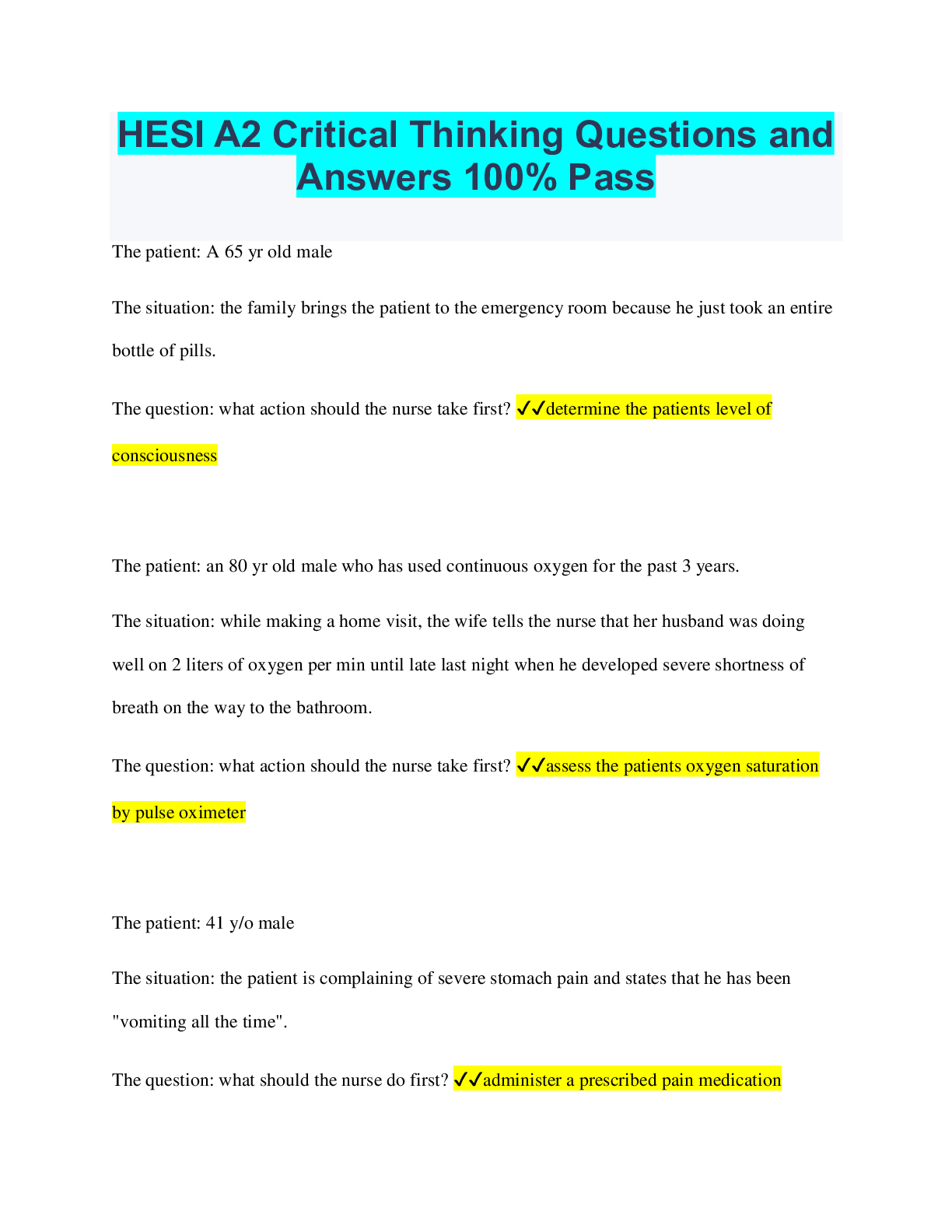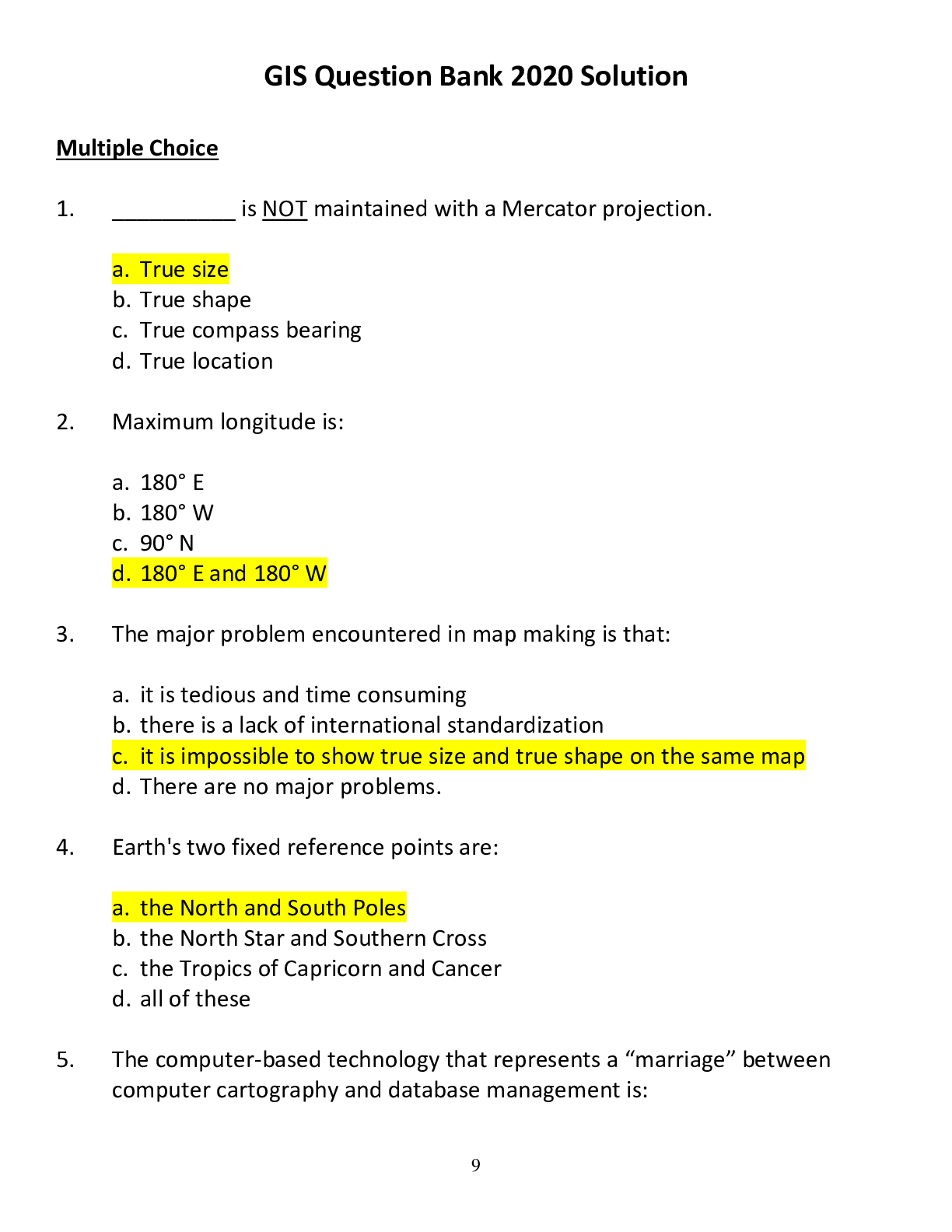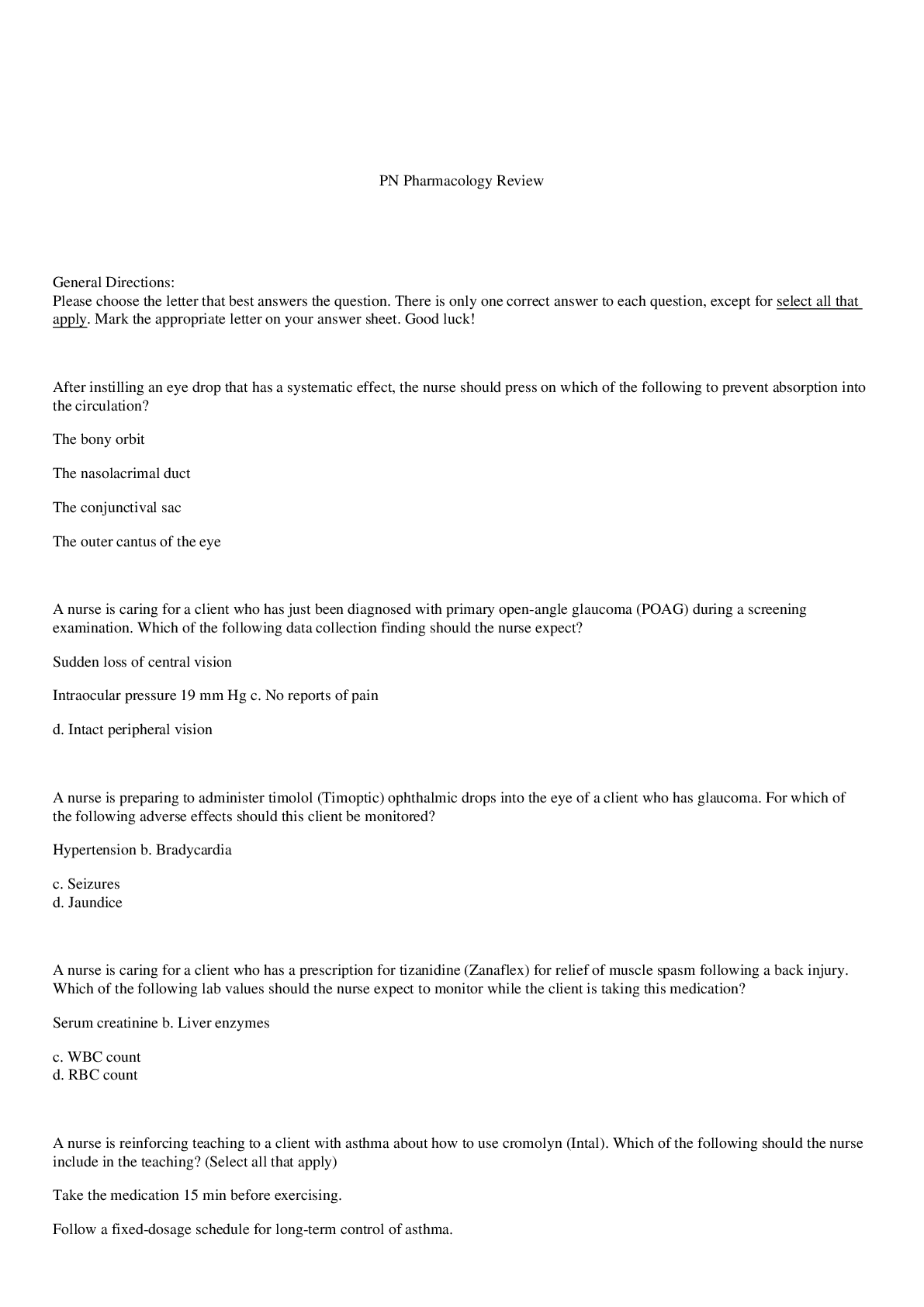Trauma Nurse Core Course (TNCC) > QUESTIONS & ANSWERS > TNCC 8th Edition Questions and Answers 100% Pass (All)
TNCC 8th Edition Questions and Answers 100% Pass
Document Content and Description Below
TNCC 8th Edition Questions and Answers 100% Pass What are the greatest risks for transport? ✔✔Loss of airway patency, displaced obstructive tubes lines or catheters, dislodge splinting devices,... need to replace or reinforce dressings, deterioration in patient status change in vital signs or level of consciousness, injury to the patient and/or team members According to newtons law which of these two force is greater: size or force? ✔✔Neither. For each force there is an equal and opposite reaction. What is the relationship between mass and velocity to kinetic energy? ✔✔Kinetic energy is equal to 1/2 the mass multiplied the square of its velocity therefore when mass is doubled so is the net energy, however, when velocity is doubled energy is quadrupled. What is tension? ✔✔stretching force by pulling at opposite ends What is compression? ✔✔Crushing by squeezing together What is bending? ✔✔Loading about an axis. Bending causes compression on the side the person is bending toward intention to the opposite side What is shearing? ✔✔Damage by tearing or bending by exerting faucet different parts in opposite directions at the same time. What is torsion? ✔✔Torsion forces twist ends in opposite directions. What is combined loading? ✔✔Any combination of tension compression torsion bending and/or shear. What are the four types of trauma related injuries? ✔✔Blunt, penetrating, thermal, or blast. What are contributing factors to injuries related to blunt traumas? ✔✔The point of impact on the patient's body, the type of surface that is hit, the tissues ability to resist (bone versus soft tissue, air-filled versus solid organs), and the trajectory of force. What are the seven patterns of pathway injuries related to motor vehicle accidents? ✔✔Up and over, down and under, lateral, rotational, rear, roll over, and ejection. Differentiate between the three impacts of motor vehicle impact sequence. ✔✔The first impact occurs when the vehicle collided with another object. The second impact occurs after the initial impact when the occupant continues to move in the original direction of travel until they collide with the interior of the vehicle or meet resistance. The third impact occurs when internal structures collide within the body cavity. What are the three factors that contribute to the damage caused by penetrating trauma's? ✔✔The point of impact, the velocity and speed of impact, and the proximity to the object. What causes the primary effects of blast traumas? ✔✔The direct blast effects. Types of injuries include last long, tympanic membrane rupture and middle ear damage, abdominal hemorrhage and perforation, global rupture, mild Trumatic brain injury. What causes the secondary effects of blast traumas? ✔✔Projectiles propelled by the explosion. Injuries include penetrating or blunt injuries or I penetration. What causes the tertiary effects of blast traumas? ✔✔Results from individuals being thrown by the blast wind. Injuries include hole or partial body translocation from being thrown against a hard service: blunt or penetrating trauma's, fractures, traumatic amputations. What causes quarternary effects of blast traumas? ✔✔All explosion related injuries, illnesses, or diseases not due to the first three mechanisms. Injuries include external and internal burns, crush injuries, closed and open brain injuries, asthmatic or breathing problems from dust smoke or toxic fumes, angina, or hyper glycemia and hypertension. What causes quinary effects of blasts traumas? ✔✔Those associated with exposure to hazardous materials from radioactive, biologic, or chemical components of a blast. Injuries include a variety of health effects depending on agent. What are the three processes that transfer oxygen from the air to the lungs and blood stream ✔✔Ventilation: the active mechanical movement of air into and out of the lungs; diffusion: the passive movement of gases from an area of higher concentration to an area of lower concentration; and perfusion: the movement of blood to and from the lungs as a delivery medium of oxygen to the entire body. When would you use a nasopharyngeal airway versus an oral pharyngeal airway? ✔✔Nasopharyngeal airways is contraindicated in patients with facial trauma or a suspected basilar skull fracture. Oral pharyngeal airways is used in unresponsive patients unable to maintain their airway, without a gag reflex as a temporary measure to facilitate ventilation with a bag mask device or spontaneous ventilation until the patient can be intubated. Describe the measurement of an NPA ✔✔Measure from the tip of the patient's nose to the tip of the patients earlobe. Measurement of an OPA ✔✔Place the proximal end or flange of the airway adjunct at the corner of the mouth to the tip of the mandibular angle. True or false: NPAs and OPAs are definitive airways. ✔✔False. When placing one of these? One should consider the potential need for a definitive airway. Name the three ways to confirm ETT placement ✔✔Placement of a CO2 monitoring device, Assessing for equal chest rise and fall, and listening at the epigastrium and four lung fields for equal breath sounds. When capnography measurement reads greater than 45MMHG, the nurse should consider increasing or decreasing the ventilation rate? ✔✔Increasing the ventilation rate. Doing so would allow the patient to blow off retained CO2. When capnography measurement reads less than 35MMHG, the nurse should consider increasing or decreasing the ventilation rate? ✔✔Decreasing the ventilation rate. By doing so, the nurse allows the patient to retain CO2. What are the three stages of shock ✔✔Compensated, decompensated or progressive, and irreversible. What are the signs of compensated shock? ✔✔Anxiety, confusion, restlessness, increased respiratory rate, narrowing pulse pressure were diastolic increases yet systolic remains unchanged, tachycardia with bounding pulses, and decreased urinary output What are the signs and symptoms of decompensated shock? ✔✔Decreased level of consciousness, hypertension, narrow pulse pressure, tachycardia with weak pulses, tachypnea, skin that is cool clammy and cyanotic, base access outside the normal range, and serum lactate levels greater than two to 4MMOL/L. What are the signs and symptoms of irreversible shock? ✔✔Obtunded stuporous or comatose state, marked hypertension and heart failure, bradycardia with possible dysrhythmias, decreased and shallow respiratory rate, pale cool and clammy skin, kidney liver and other organ failure, severe acidosis, elevated lactic acid levels, worsening base access on ABGs, coagulopathies with petechiae purpura or bleeding. What are the four types of shock? ✔✔Hypovolemic, Cardiogenic, Obstructive, & Distributive What is the trauma triad of death? ✔✔hypothermia, acidosis, coagulopathy Describe the characteristics of obstructive shock ✔✔Obstructive shock is it mechanical problem that results from hypoperfusion of the tissue due to an obstruction in either the vasculature or the heart resulting in decreased cardiac output. Some causes include a tension pneumothorax, cardiac tamponade, or venous air embolism on the right side of the heart during systole in the pulmonary artery.Signs include anxiety, muffled heart sounds, JVD, hypertension, chest pain, difficulty breathing, or pulses paradoxes. Describe the characteristics of cardiogenic shock ✔✔Cardiogenic shock results from pump failure in the presence of adequate intravascular volume. Lack of cardiac output and an organ perfusion occurs secondary to a decrease in myocardial contractility and or valvular insufficiency. This can happen with blunt cardiac trauma or an MI. Symptoms can include low blood pressure increase heart rate and respiratory rate chest pain shortness of breath dysrhythmias increase troponin and pale cool moist skin Describe the characteristics of distributive shock. ✔✔Distributive shock occurs as a result of Mel distribution of an adequate circulating blood volume with the loss of vascular tone or increased permeability. This can occur with spinal cord injuries, sepsis, or anaphylaxis. Symptoms include low blood pressure heart rate respiratory rate preload and afterload, spinal tenderness, difficulty breathing, warm pink and dry skin with a cool core temperature. Describe the characteristics of hypovolemic shock ✔✔Hypovolemia is caused by a decrease in the amount of circulating volume usually caused by massive bleeding, but also can be from vomiting and diarrhea. Characteristics include low blood pressure and preload, increase heart rate respiratory rate and afterload, with contractility unchanged. Signs include obvious bleeding, weak peripheral pulses, pale cool and moist skin, distended abdomen, pelvic fracture, or bruise swollen and deformed extremities especially long bones. What is the recommended fluid bolus for a trauma? ✔✔500 ML's of warmed isotonic crystalloid. Ongoing fluid boluses of 500 ML's should be given judiciously with constant reassessments after administration. What is the minimum permissive hypertension and a trauma patient? ✔✔A systolic of greater than or equal to 90 MMHG What is the minimum permissive oxygenation level of a trauma patient? ✔✔Greater than or equal to 94% What is Cullen's sign and its significance? ✔✔Cullens sign is periumbilical bruising and is indicative of intraperitoneal bleeding Define Cushing's triad ✔✔Bradycardia, progressive hypertension (widening pulse pressure), and decreased respiratory effort What are the early signs of increased Intracranial pressure ✔✔headache, vomiting, behavioral changes that begin with restlessness and may progress to confusion, drowsiness, or impaired judgment What are the late signs of Increased intracranial pressure ✔✔dilated, non-reactive pupil(s); abnormal motor posturing (flexion, extension, flaccidity); Cushing's triad, Unresponsive to per verbal and painful stimuli, bradycardia and decreased respiratory effort What are the symptoms of a subdural hematoma? ✔✔Decreased LOC, nausea vomiting headache and ipsilateral pupillary changes What is a trademark symptom of an epidural hematoma ✔✔Loss of consciousness then awake and alert then loss of consciousness Define the characteristics of neurogenic shock ✔✔Distributive shock with a T6 or higher injury results and vasodilation, bradycardia, flushed warm dry skin. Risk for temperature instability. Nursing interventions include maintaining warmth and spinal stabilization. Define the characteristics of spinal shock ✔✔Transient loss of function can include loss of reflexes and muscle tone below the level of industry with possible vascular response. Describe the four types of spinal cord injury ✔✔Central cord injury results in greater weakness distally, anterior injury includes motor loss or weakness below the cord level of injury yet sensory is intact, Brown-Sequard (hemicord) is weak on one side with sensory deficit on opposite side, posterior cord syndrome although rare is when the patient is unable to use sense vibration in proprioception Describe one fat embolism syndrome is most likely to occur in its characteristics ✔✔With longform fractures. Tachycardia, Thrombocytopenia, and petechiae rash. What is the Munro-Kellie doctrine? ✔✔Within the skull 80% his brain, 10% is blood, and 10% is CSF. Any increase of any of the products results in increased intracranial pressure. What are the treatment goals for a TBI? ✔✔O2 saturation > or equal to 95%, systolic blood pressure > or equal to 100 MMHG, ICP < 15 MMHG, CPP > or equal to 60 MMHG, normal glycemia, hemoglobin > or equal to 7 g/DL, sodium 135-145, osmotic diuretics, anti-emetics, sedatives, anticonvulsants, head of bed at 30°, and neck at midline [Show More]
Last updated: 2 years ago
Preview 1 out of 11 pages

Buy this document to get the full access instantly
Instant Download Access after purchase
Buy NowInstant download
We Accept:

Reviews( 0 )
$10.00
Can't find what you want? Try our AI powered Search
Document information
Connected school, study & course
About the document
Uploaded On
Jun 09, 2023
Number of pages
11
Written in
Additional information
This document has been written for:
Uploaded
Jun 09, 2023
Downloads
0
Views
89















 Questions and Answers (latest Update).png)
.png)









